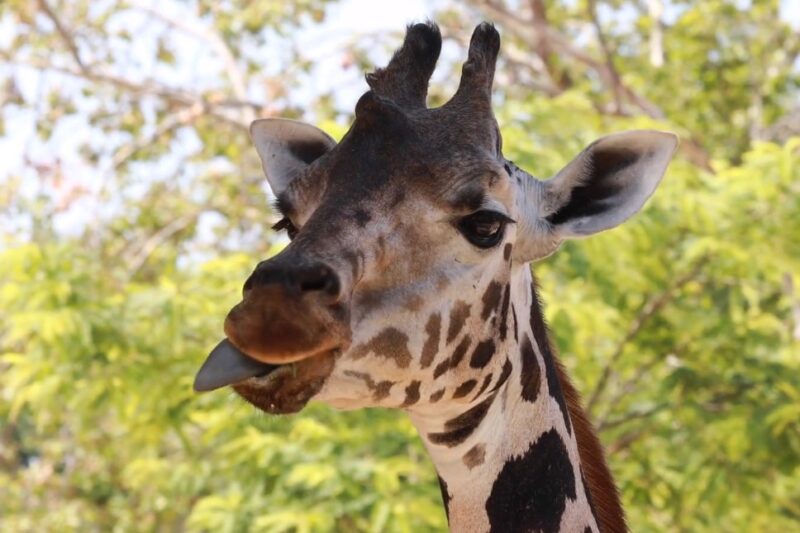Giraffes, one of the African animals, with their towering necks and elegant stature, are often the first creatures noticed in a savannah landscape. Their tongues, much like their necks, are a marvel of nature.
Stretching to lengths that can reach an astounding 20 inches, it’s a feature that sets them apart from other land animals. But this isn’t just a random trait; it’s a result of millions of years of evolution, ensuring their survival in the wild.
Beyond its impressive length, the giraffe’s tongue boasts a unique protective feature. It is enveloped in a robust, dark-colored layer.
This isn’t merely a coloration quirk. This specialized coating serves a vital purpose: protection.
Acacia trees, which form a significant portion of the giraffe’s diet, are armed with sharp thorns. The tongue’s protective layer ensures that while the giraffe navigates through these thorny branches to feed on the lush leaves, it doesn’t sustain injuries.
Here is a compilation of remarkable traits found in the giraffe’s tongue, which serve as nature’s mechanism to aid efficient feeding and minimize the risk of harm to the animal.
1. Unparalleled Length
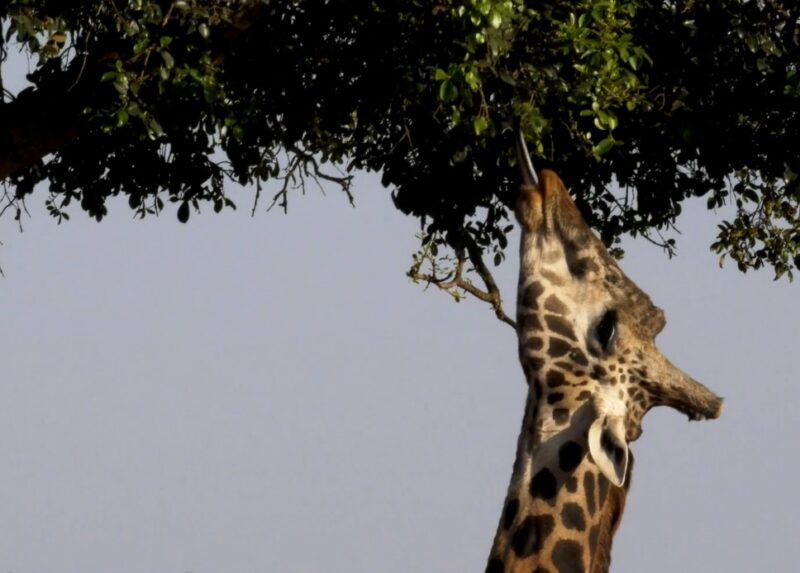
Within the vast spectrum of terrestrial creatures, giraffes stand out, not just for their towering stature but also for their impressively long tongues. While many might perceive this length as a mere spectacle, it serves a far more critical purpose.
This extended reach is a product of evolution, tailored to ensure giraffes can access food sources that other animals can’t. The tongue’s length allows them to feed from taller trees, ensuring a consistent food supply even when lower vegetation is scarce, thereby playing a pivotal role in their survival strategy.
2. Prehensility
The giraffe’s tongue is not just long; it’s incredibly versatile. Its prehensile nature is akin to a multi-functional tool. Imagine having the ability to grip, twist, and even wrap around objects – that’s what the giraffe’s tongue can do.
This adaptability is particularly beneficial when they’re feeding on trees or shrubs, allowing them to pluck leaves with precision. It’s as if they have an extra hand, one that’s perfectly designed for their dietary needs.
3. Protective Coating
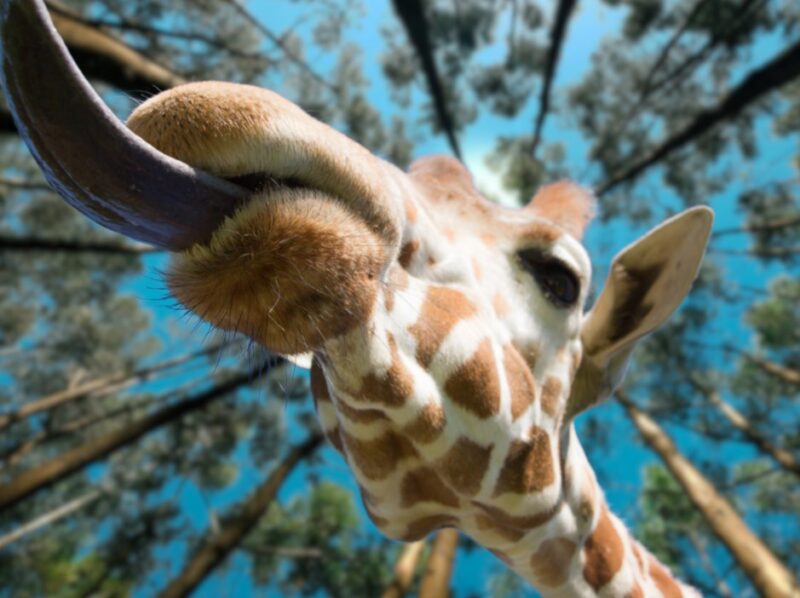
Nature, in its infinite wisdom, has equipped the giraffe’s tongue with a protective layer. This dark, dense coating acts as a natural armor, shielding the tongue from potential injuries.
Given that giraffes often feed on acacia trees, which are laden with sharp thorns, this protective layer is essential. It ensures that even when they’re navigating through thorny branches, their tongues remain unscathed, allowing them to feed comfortably and efficiently.
4. Muscular Build
The giraffe’s tongue is a powerhouse. Its muscular build is nothing short of remarkable, allowing it to stretch, contract, and maneuver with ease.
This muscularity is crucial for its feeding habits. Giraffes can extend their tongues to great lengths, reaching out to leaves that are often inaccessible to other herbivores.
This ability ensures they have a diverse range of feeding options, further enhancing their survival chances in varied habitats.
5. Multifunctional Tool
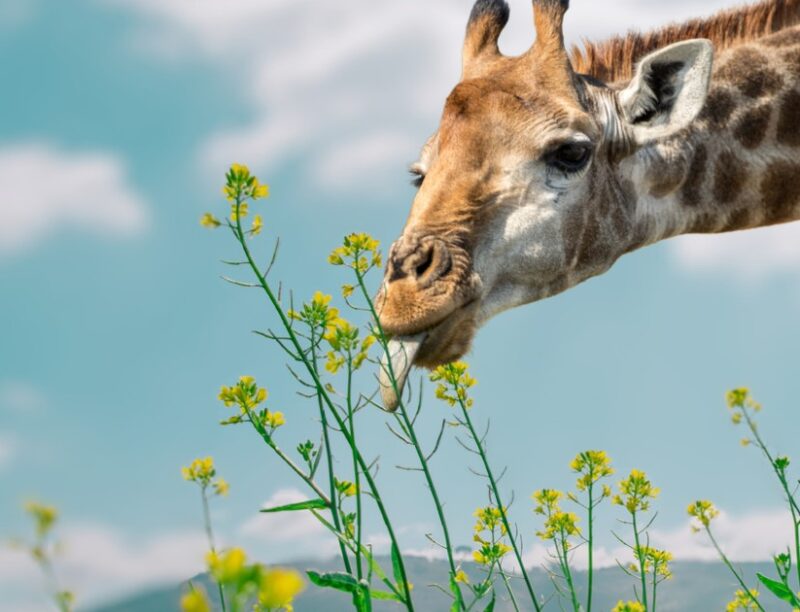
The versatility of the giraffe’s tongue is truly commendable. Beyond its primary role in feeding, it serves multiple other functions.
One of its notable roles is grooming. Giraffes use their tongues to clean their fur, ensuring they remain free from parasites and dirt.
Additionally, in the arid and dusty terrains of Africa, their eyes and ears can accumulate dust. The tongue comes to the rescue, allowing giraffes to lick and clean these sensitive areas, ensuring they remain free from irritations and potential infections.
6. Swallowing Aid
The giraffe’s tongue is not just an instrument for procuring food; it’s also integral to the consumption process. Its unique design, combined with its textured surface, plays a pivotal role in the swallowing mechanism.
As giraffes chew their food, the tongue skillfully maneuvers the bolus (chewed food) to the back of the throat, facilitating a seamless swallowing process. This ensures that the food is directed correctly down the esophagus, preventing choking and ensuring efficient digestion in the stomach.
7. Salivation Mechanism
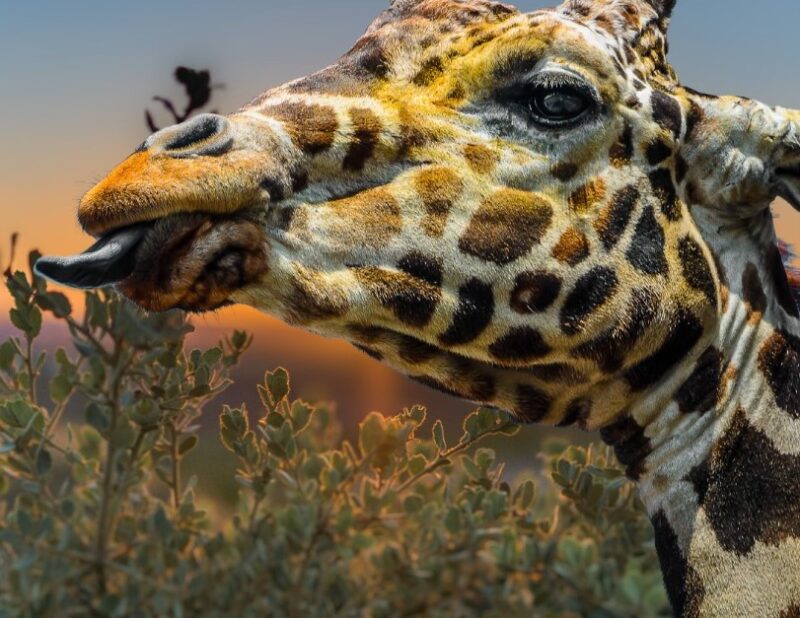
Feeding giraffes is a meticulous process, and saliva plays a crucial role in it. As they chew, their salivary glands produce a generous amount of saliva.
This not only aids in the initial breakdown of food, making it easier to digest but also serves a protective function. The saliva creates a lubricated barrier, which, when combined with the tongue’s protective coating, offers a double defense against the sharp thorns of their primary food sources, like acacia trees.
8. Dietary Essential
The tongue is more than just an organ for giraffes; it’s a lifeline. Central to their feeding habits, its design and functionality ensure they can access a diverse range of foliage.
The tongue’s length, flexibility, and strength enable giraffes to reach out to higher branches, ensuring they get the necessary nutrients and energy to sustain their large frames and active lifestyles.
9. Precision and Dexterity
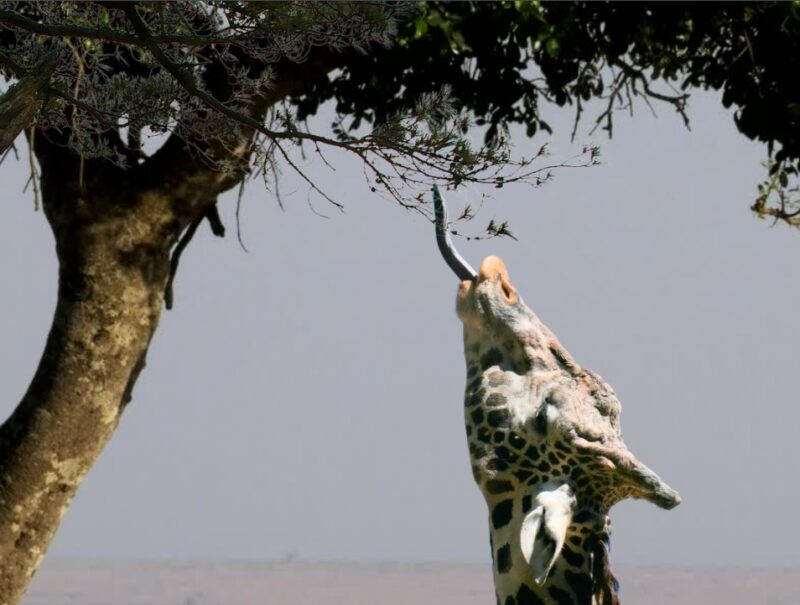
Despite its impressive length, the giraffe’s tongue operates with remarkable precision. Its dexterity allows it to navigate through dense foliage, wrapping around even the most delicate leaves.
This ensures that giraffes can make the most of available food sources, leaving no leaf unturned, quite literally. This ability to feed efficiently is crucial, especially in environments where food might be scarce.
10. Adaptive Marvel
The giraffe tongue is a testament to the wonders of evolution. Over millennia, as giraffes evolved to adapt to their environment, so did their tongues.
Every aspect, from its length to its protective coating, has been honed to perfection, ensuring giraffes can thrive in their unique habitats. It’s a vivid reminder of how nature, over time, crafts solutions to challenges, ensuring the survival and prosperity of species.
Further Insights
- Spiny Surface: The surface of the giraffe’s tongue is textured with tiny, backward-facing spines or papillae. These structures enhance the tongue’s grip, ensuring that leaves, once held, remain secure during the feeding process.
- Supreme Flexibility: The flexibility of the giraffe tongue is unmatched. This adaptability allows them to reach leaves situated at varying heights, maximizing their feeding potential.
- Self-Cleaning Mechanism: The ability of giraffes to lick their own eyes is not just a quirky fact. It’s a vital self-cleaning mechanism, especially beneficial in the dusty terrains they inhabit.
- Social Connector: The tongue plays a pivotal role in giraffe social dynamics. Mutual grooming, facilitated by their tongues, is a communal activity that strengthens bonds, ensuring a cohesive and supportive herd structure.
In essence, the giraffe tongue is a masterclass in evolutionary design, perfectly tailored to the unique challenges and needs of these magnificent creatures.
FAQs
How often does a giraffe use its tongue?
Giraffes use their tongues all day long. They use them to eat, groom, and clean themselves.
Are giraffe tongues sensitive?
Yes, giraffe tongues are very sensitive. They can detect even the slightest changes in temperature or taste.
This allows giraffes to select the most nutritious leaves to eat.
Can a giraffe’s tongue get injured?
Yes, a giraffe’s tongue can get injured. If a giraffe bites its tongue or if it gets cut on a thorn, it can bleed profusely. Giraffes have a good ability to heal, but they can lose a lot of blood from a tongue injury.
Final Words
The giraffe, an emblem of Africa’s vast savannah, is a creature that never ceases to fascinate. Its towering presence is complemented by a tongue that is an evolutionary marvel.
This organ, stretching impressively, is not just about size but is a symphony of features that ensure the giraffe’s survival. From its protective coating, safeguarding against thorny meals, to its dexterity, ensuring every leaf is within reach, the tongue is a testament to nature’s genius.
Its multifunctional roles, from feeding to grooming, highlight its significance in the giraffe’s daily life. As we delve into the intricacies of this organ, we’re reminded of the intricate tapestry of adaptations that nature weaves, ensuring each species is equipped to thrive in its habitat.
The giraffe’s tongue is not just an organ; it’s a story of evolution, adaptation, and the wonders of the natural world.
Related Posts:
- 8 Facts You May Not Know About The Armadillo Shell -…
- Why Are Cats Mammals? Interesting Facts You Probably…
- Understanding Bear Scat - Nature's Storyteller
- 15 Wildest Apex Predators: Nature's Nightmare
- Connecting Kids to Nature: Making Ecology Homework…
- 15 Tips for Shooting & Editing Drone Videos of Nature


